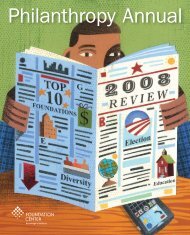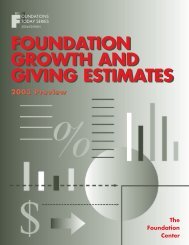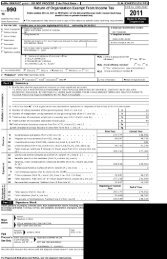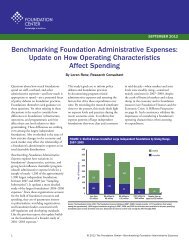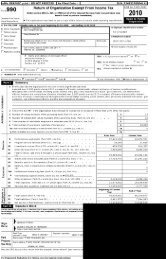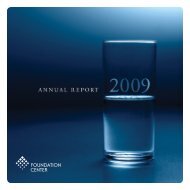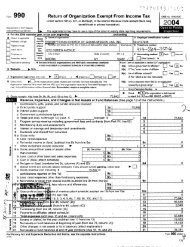Download Philanthropy Annual PDF - Foundation Center
Download Philanthropy Annual PDF - Foundation Center
Download Philanthropy Annual PDF - Foundation Center
Create successful ePaper yourself
Turn your PDF publications into a flip-book with our unique Google optimized e-Paper software.
TopStoriesintheNews<br />
2010: Preview of the Year Ahead<br />
If the headlines in 2009 were dominated by a single story,<br />
namely the near-death and revival of the economy, 2010 is likely to<br />
see a renewed focus on efforts to meet the challenges — and leverage<br />
the opportunities — posed by globalization and accelerating<br />
technological change.<br />
ot that the economy, and<br />
certainly not the nonprofit<br />
economy, is out of the woods.<br />
In October, the Chronicle of<br />
<strong>Philanthropy</strong>’s annual <strong>Philanthropy</strong> 400<br />
survey found that large charities remain<br />
gloomy about their fundraising prospects,<br />
while the results of a recent survey<br />
by the <strong>Foundation</strong> <strong>Center</strong> suggest that<br />
foundation giving will fall further in<br />
2010 after a 10 percent decline in 2009.<br />
The same survey suggests that most<br />
funders believe that nonprofits were not<br />
sufficiently prepared to weather a severe<br />
economic downturn and that the crisis<br />
is likely to take a toll on smaller, weaker<br />
organizations, leading to more collaborations<br />
and an emphasis on greater<br />
transparency and accountability within<br />
the sector. We shall see.<br />
If the economy does recover and the<br />
federal government is able to stop and<br />
begin to reverse the alarming deterioration<br />
in its finances, nonprofits are certain<br />
to step up the pressure on the White<br />
House for more assistance and leadership<br />
on a range of issues, from tax and<br />
regulatory policy, to the environment, to<br />
encouraging public–private partnerships<br />
that truly support social innovation. With<br />
meaningful (if flawed) healthcare reform<br />
a near-certainty, attention will shift to<br />
the education arena, where hundreds<br />
of billions of dollars spent over decades<br />
have done little to close the educational<br />
achievement gaps between low-income<br />
students and their more affluent peers,<br />
between white students and students of<br />
color, and between the United States and<br />
other high-performing nations.<br />
Growing income disparities across<br />
regions and different socioeconomic<br />
strata are also likely to come to the<br />
fore — especially if the economy slows<br />
or falls back into recession. As Boston<br />
<strong>Foundation</strong> president and CEO Paul S.<br />
Grogan put it earlier this fall, “[G]rowing<br />
inequality . . . threatens our optimistic<br />
assumptions about the future. The<br />
American Dream, especially for urban<br />
families with children, is receding and<br />
the question . . . is: Can we rise to the<br />
challenge to heal the growing divide?”<br />
One should expect to see foundations<br />
and nonprofits answer Grogan’s<br />
call — and to employ every tool at their<br />
disposal in doing so. The use of social<br />
media to drive engagement, awareness,<br />
collaboration, and financial support for<br />
causes and organizations will accelerate,<br />
and it’s quite possible we will see the<br />
release of a “killer app” during the year<br />
that galvanizes new enthusiasm for and<br />
investment in the work of the social<br />
sector. Of course, a higher profile for<br />
the sector will lead to calls for individual<br />
nonprofits to demonstrate their<br />
impact. There will be pushback, as there<br />
always is, against the “quantification” of<br />
social change work, but that train has<br />
left the station — and 2010 will see<br />
more people hopping on board.<br />
As revenue-constrained organizations<br />
continue to look for ways to cut<br />
costs and create opportunities for their<br />
digitally savvy 20- and 30-somethings,<br />
an uptick in leadership transitions within<br />
the sector will be another trend to keep<br />
an eye on in 2010. The boomers have<br />
had a great ride and done more than<br />
anyone could have imagined to turn the<br />
nonprofit sector into a positive force<br />
for change. As more of them retire over<br />
the coming months and years, let’s not<br />
forget the debt we owe them.<br />
Related stories from<br />
<strong>Philanthropy</strong><br />
News Digest:<br />
http://foundationcenter.org/pnd/<br />
> “Educational, Economic<br />
Achievement Gaps Correlated,<br />
Reports Find” (4/24/09)<br />
> “Fundraising Environment for<br />
America’s Largest Charities<br />
Still Challenging, Survey Finds”<br />
(10/31/09)<br />
> “Drop in <strong>Foundation</strong> Giving May Be<br />
Steeper Than Anticipated, Report<br />
Finds” (11/5/09)<br />
> “Most Nonprofit Retirement<br />
Benefit Plans Under ‘Stress,’<br />
Report Finds” (11/10/09)<br />
> “Online Giving Campaign Raises<br />
$14 Million for Minnesota<br />
Nonprofits” (11/20/09)<br />
> “Report Details Growing Income<br />
Disparities in Greater Boston<br />
Area” (12/18/09)<br />
GO<br />
Top Stories in the News | 13



